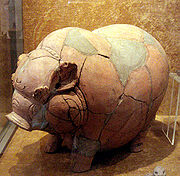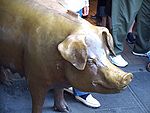
Piggy bank
Encyclopedia

Coin
A coin is a piece of hard material that is standardized in weight, is produced in large quantities in order to facilitate trade, and primarily can be used as a legal tender token for commerce in the designated country, region, or territory....
accumulation and storage receptacle; it is most often, but not exclusively, used by child
Child
Biologically, a child is generally a human between the stages of birth and puberty. Some vernacular definitions of a child include the fetus, as being an unborn child. The legal definition of "child" generally refers to a minor, otherwise known as a person younger than the age of majority...
ren. The piggy bank is known to collectors as a "still bank" as opposed to the "mechanical bank
Mechanical bank
Cast iron mechanical banks have been a collectors item since the mid-19th century. They were originally designed to promote saving among children. To make these banks appealing to kids, they were cleverly designed, often depicting historical, legendary or everyday events. Each bank performs a...
s" popular in the early 20th century. These items are also often used by corporations for promotional purposes. Their shape is most often that of a little pig
Pig
A pig is any of the animals in the genus Sus, within the Suidae family of even-toed ungulates. Pigs include the domestic pig, its ancestor the wild boar, and several other wild relatives...
. Many financial services companies use piggy banks as logos for their savings products.
Piggy banks are typically made of ceramic
Ceramic
A ceramic is an inorganic, nonmetallic solid prepared by the action of heat and subsequent cooling. Ceramic materials may have a crystalline or partly crystalline structure, or may be amorphous...
or porcelain
Porcelain
Porcelain is a ceramic material made by heating raw materials, generally including clay in the form of kaolin, in a kiln to temperatures between and...
, and serve as a pedagogical device to teach the rudiments of thrift
Thrift
Thrift may refer to:* A savings and loan association in the United States* Restrained or disciplined spending habits* Apache Thrift a remote procedure call framework developed at Facebook for "scalable cross-language services development"....
and savings to children; money can be easily inserted, but in the traditional type of bank the pig must be broken open for it to be retrieved. Most modern piggy banks, however, have a rubber plug
Bung
A bung is truncated cylindrical or conical closure to seal a container, such as a bottle, tube or barrel. Unlike a lid which encloses a container from the outside without displacing the inner volume, a bung is partially inserted inside the container to act as a seal...
located on the underside; others are made of vinyl and have a removable nose for easy coin access. Some piggy banks incorporate electronic
Electronics
Electronics is the branch of science, engineering and technology that deals with electrical circuits involving active electrical components such as vacuum tubes, transistors, diodes and integrated circuits, and associated passive interconnection technologies...
systems which calculate the amount of money deposited.
Etymology

Middle English
Middle English is the stage in the history of the English language during the High and Late Middle Ages, or roughly during the four centuries between the late 11th and the late 15th century....
, "pygg
Pygg
Pygg is a type of orange clay, once widely used for making pottery in the form of jars, cookware, and other household items due to its economical characteristics....
" referred to a type of clay used for making various household objects such as jar
Jar
A jar is a rigid, approximately cylindrical container with a wide mouth or opening. Jars are typically made of glass, ceramic, or plastic. They are used for foods, cosmetics, medications, and chemicals that are relatively thick or viscous...
s. People often saved money
Money
Money is any object or record that is generally accepted as payment for goods and services and repayment of debts in a given country or socio-economic context. The main functions of money are distinguished as: a medium of exchange; a unit of account; a store of value; and, occasionally in the past,...
in kitchen
Kitchen
A kitchen is a room or part of a room used for cooking and food preparation.In the West, a modern residential kitchen is typically equipped with a stove, a sink with hot and cold running water, a refrigerator and kitchen cabinets arranged according to a modular design. Many households have a...
pots and jars made of pygg, called "pygg jars". By the 18th century, the spelling of "pygg" had changed and the term "pygg jar" had evolved to "pig bank." Once the meaning had transferred from the substance to the shape, piggy banks began to be made from other substances, including glass
Glass
Glass is an amorphous solid material. Glasses are typically brittle and optically transparent.The most familiar type of glass, used for centuries in windows and drinking vessels, is soda-lime glass, composed of about 75% silica plus Na2O, CaO, and several minor additives...
, plaster
Plaster
Plaster is a building material used for coating walls and ceilings. Plaster starts as a dry powder similar to mortar or cement and like those materials it is mixed with water to form a paste which liberates heat and then hardens. Unlike mortar and cement, plaster remains quite soft after setting,...
, and plastic
Plastic
A plastic material is any of a wide range of synthetic or semi-synthetic organic solids used in the manufacture of industrial products. Plastics are typically polymers of high molecular mass, and may contain other substances to improve performance and/or reduce production costs...
.
An alternative theory, and the one usually given for the origin in German sources, is that in Germany and surrounding countries the pig is a symbol of good luck or good fortune (see Pigs in folklore), hence keeping money in a piggy bank will bring good fortune.
The oldest find of a money box dates from 2nd century B.C. Greek colony Priene
Priene
Priene was an ancient Greek city of Ionia at the base of an escarpment of Mycale, about north of the then course of the Maeander River, from today's Aydin, from today's Söke and from ancient Miletus...
, Asia Minor
Asia Minor
Asia Minor is a geographical location at the westernmost protrusion of Asia, also called Anatolia, and corresponds to the western two thirds of the Asian part of Turkey...
, and features the shape of a little Greek temple
Greek temple
Greek temples were structures built to house deity statues within Greek sanctuaries in Greek paganism. The temples themselves did usually not directly serve a cult purpose, since the sacrifices and rituals dedicated to the respective deity took place outside them...
with a slit in the pediment
Pediment
A pediment is a classical architectural element consisting of the triangular section found above the horizontal structure , typically supported by columns. The gable end of the pediment is surrounded by the cornice moulding...
. Money boxes of various forms were also excavated in Pompeii
Pompeii
The city of Pompeii is a partially buried Roman town-city near modern Naples in the Italian region of Campania, in the territory of the comune of Pompei. Along with Herculaneum, Pompeii was destroyed and completely buried during a long catastrophic eruption of the volcano Mount Vesuvius spanning...
and Herculaneum
Herculaneum
Herculaneum was an ancient Roman town destroyed by volcanic pyroclastic flows in AD 79, located in the territory of the current commune of Ercolano, in the Italian region of Campania in the shadow of Mt...
, and appear quite frequently on late ancient
Late Antiquity
Late Antiquity is a periodization used by historians to describe the time of transition from Classical Antiquity to the Middle Ages, in both mainland Europe and the Mediterranean world. Precise boundaries for the period are a matter of debate, but noted historian of the period Peter Brown proposed...
provincial
Roman province
In Ancient Rome, a province was the basic, and, until the Tetrarchy , largest territorial and administrative unit of the empire's territorial possessions outside of Italy...
sites, particularly in Roman Britain
Roman Britain
Roman Britain was the part of the island of Great Britain controlled by the Roman Empire from AD 43 until ca. AD 410.The Romans referred to the imperial province as Britannia, which eventually comprised all of the island of Great Britain south of the fluid frontier with Caledonia...
and along the Rhine.

Parallel evolution
Parallel evolution is the development of a similar trait in related, but distinct, species descending from the same ancestor, but from different clades.-Parallel vs...
, the Indonesian term celengan (a celeng is a wild boar, with the "an" affix used to denote a likeness) was also used in the context of domestic banks. The etymology of the word is obscure, but evident in a Majapahit piggy bank from the 15 century A.D.
Uses
The general use of piggy banks is to store loose change in a quaint, decorative manner. Modern piggy banks are not limited to the likeness of pigs, and may come in a range of animal shapes, sizes and colours. Some collect piggy banks as a hobby.Famous piggy banks
Rachel, the official mascot of Pike Place MarketPike Place Market
Pike Place Market is a public market overlooking the Elliott Bay waterfront in Seattle, Washington, United States. The Market opened August 17, 1907, and is one of the oldest continually operated public farmers' markets in the United States. It is a place of business for many small farmers,...
in Seattle, Washington, is a bronze cast piggy bank that weighs nearly 600 pounds, located at the corner of Pike Place under the "Public Market Center" sign.

Whidbey Island
Whidbey Island is one of nine islands located in Island County, Washington, in the United States. Whidbey is located about north of Seattle, and lies between the Olympic Peninsula and the I-5 corridor of western Washington...
and was the 1977 Island County prize-winner. Rachel receives roughly $9,000 annually in just about every type of world currency
World currency
In the foreign exchange market and international finance, a world currency, supranational currency, or global currency refers to a currency in which the vast majority of international transactions take place and which serves as the world's primary reserve currency...
, which is collected by the Market Foundation to fund the Market's social services.
The Disney/Pixar movies Toy Story
Toy Story
Toy Story is a 1995 American computer-animated film released by Walt Disney Pictures. It is Pixar's first feature film as well as the first ever feature film to be made entirely with CGI. The film was directed by John Lasseter and featuring the voices of Tom Hanks and Tim Allen...
, Toy Story 2
Toy Story 2
Toy Story 2 is a 1999 American computer animated film directed by John Lasseter and co-directed by Lee Unkrich and Ash Brannon. It is the sequel to the 1995 film Toy Story, released by Walt Disney Pictures and the third film to be produced by Pixar...
and Toy Story 3
Toy Story 3
Toy Story 3 is a 2010 American 3D computer-animated comedy-adventure film, and the third installment in the Toy Story series. It was produced by Pixar and released by Walt Disney Pictures. It was directed by Lee Unkrich. The film was released worldwide from June through October in Disney Digital...
feature a character named Hamm, a wisecracking, animated piggy bank.
External links
- What's the origin of the piggy bank? (from The Straight Dope)

